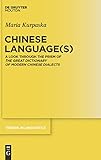Chinese Language(s) : A Look through the Prism of The Great Dictionary of Modern Chinese Dialects / Maria Kurpaska.
Material type: TextSeries: Trends in Linguistics. Studies and Monographs [TiLSM] ; 215Publisher: Berlin ; Boston : De Gruyter Mouton, [2010]Copyright date: ©2010Description: 1 online resource (276 p.)Content type:
TextSeries: Trends in Linguistics. Studies and Monographs [TiLSM] ; 215Publisher: Berlin ; Boston : De Gruyter Mouton, [2010]Copyright date: ©2010Description: 1 online resource (276 p.)Content type: - 9783110219142
- 9783110219159
- 495.1 495.1/703 495.1703
- PL1547 .K87 2010
- online - DeGruyter
- Issued also in print.
| Item type | Current library | Call number | URL | Status | Notes | Barcode | |
|---|---|---|---|---|---|---|---|
 eBook
eBook
|
Biblioteca "Angelicum" Pont. Univ. S.Tommaso d'Aquino Nuvola online | online - DeGruyter (Browse shelf(Opens below)) | Online access | Not for loan (Accesso limitato) | Accesso per gli utenti autorizzati / Access for authorized users | (dgr)9783110219159 |
Frontmatter -- Contents -- Abbreviations -- List of tables, diagrams and illustrations -- Chapter 1. Defining terminology -- Chapter 2. Languages of China -- Chapter 3. The language policy of the People’s Republic of China regarding the dialects of Chinese -- Chapter 4. Chinese historical phonetics -- Chapter 5. Classifications of Chinese dialects -- Chapter 6. The classification of Chinese dialects according to The Language Atlas of China -- Chapter 7. Guidelines for field research of Chinese dialects -- Chapter 8. Analysis of The Great Dictionary of Modern Chinese Dialects -- Chapter 9. Information gathered from The Great Dictionary of Modern Chinese Dialects -- Chapter 10. Summary and conclusions -- Backmatter
restricted access online access with authorization star
http://purl.org/coar/access_right/c_16ec
The major aim of the book is to trace the current structuring of the Chinese language(s) on the ground of Chinese linguistics. The research presented is based on the newest and most renowned sources, namely The Great Dictionary of Modern Chinese Dialects, and the Language Atlas of China. The author discusses the role The Great Dictionary plays in analyzing the spectrum of linguistic differentiation in China and gives a detailed account of the kind of information the dictionary provides. As background, she sketches the development and current state of Chinese dialectology and dialect research. One of the author's aims is to show respect for the grand achievement the Dictionary undoubtedly is, but also to emphasize a critical distance to some of the views presented in it. Apart from being an analysis of this particular Dictionary, the book presents data about the state of modern Chinese dialectology. It provides information about different classifications of the dialects and explains on what basis the classifications are made. Looking at Chinese dialectology from a Western point of view, the author aims to understand and present the Chinese perspective. The book fills an important gap in the field of Western sinology. So far, despite lively discussions concerning the status of the varieties of Chinese and their taxonomy, full-scale studies on Chinese dialects have been almost non-existent in the Western World.
Issued also in print.
Mode of access: Internet via World Wide Web.
In English.
Description based on online resource; title from PDF title page (publisher's Web site, viewed 28. Feb 2023)


